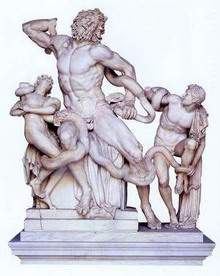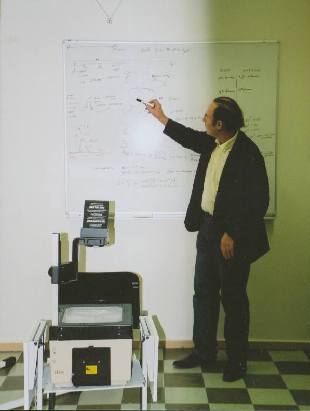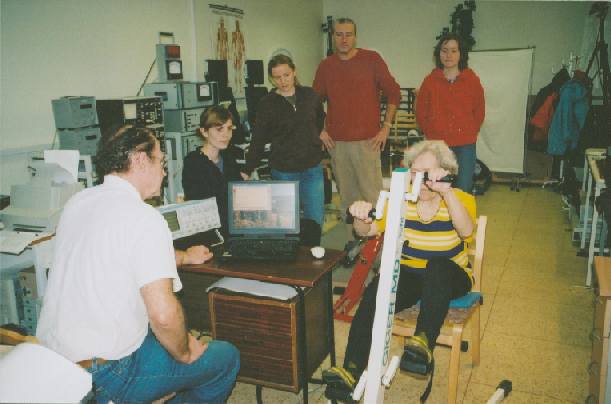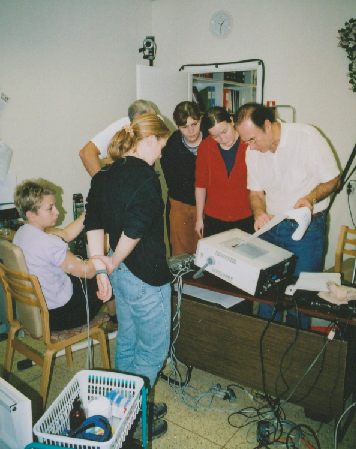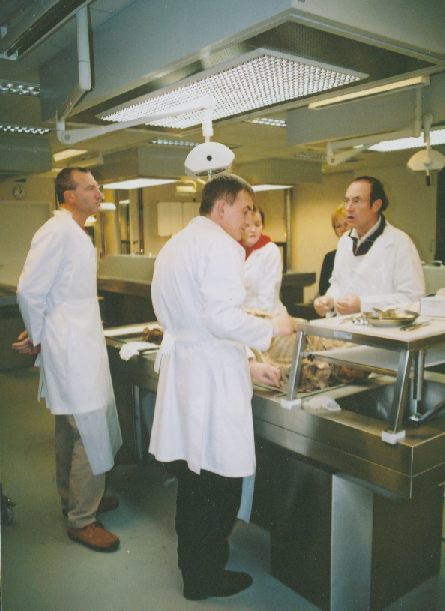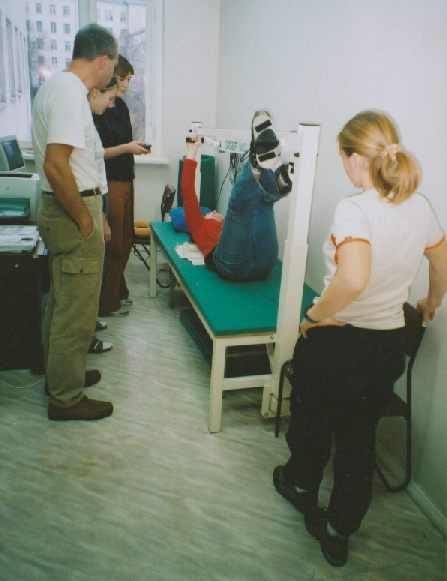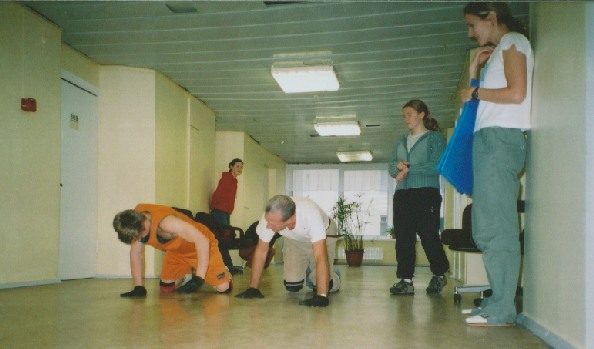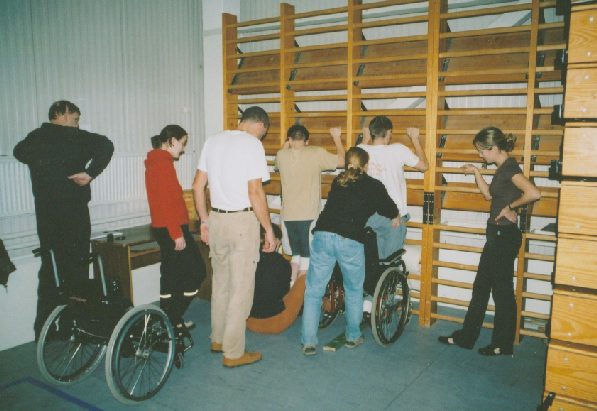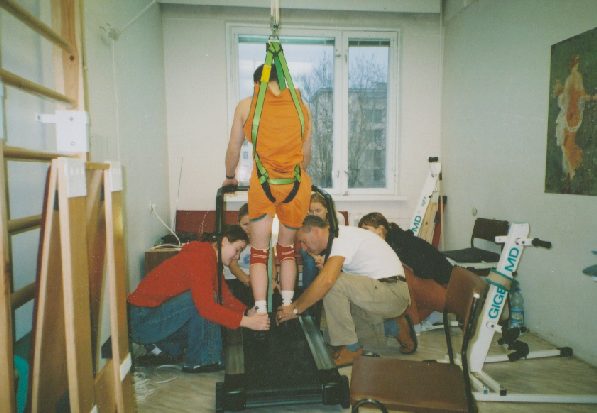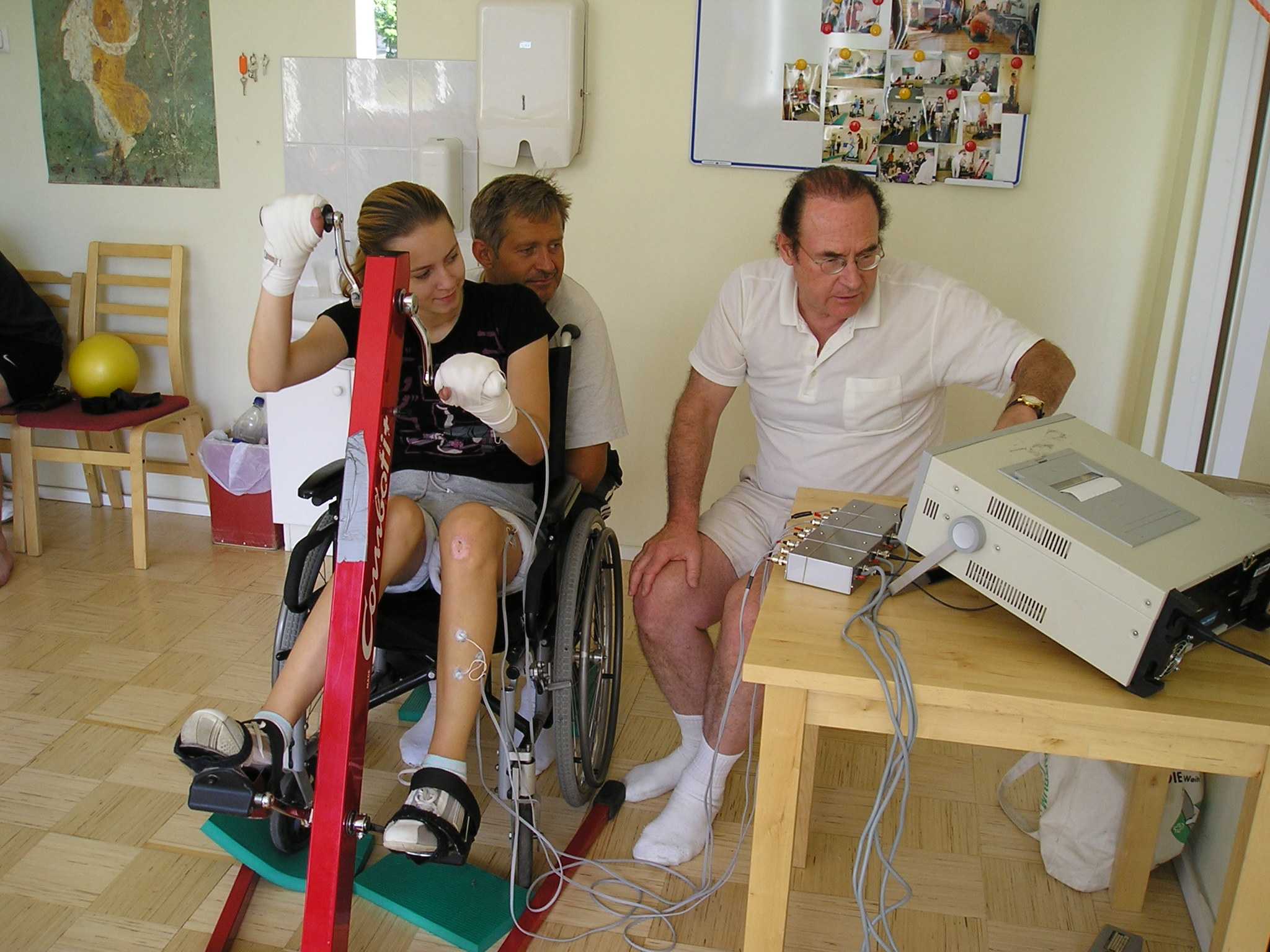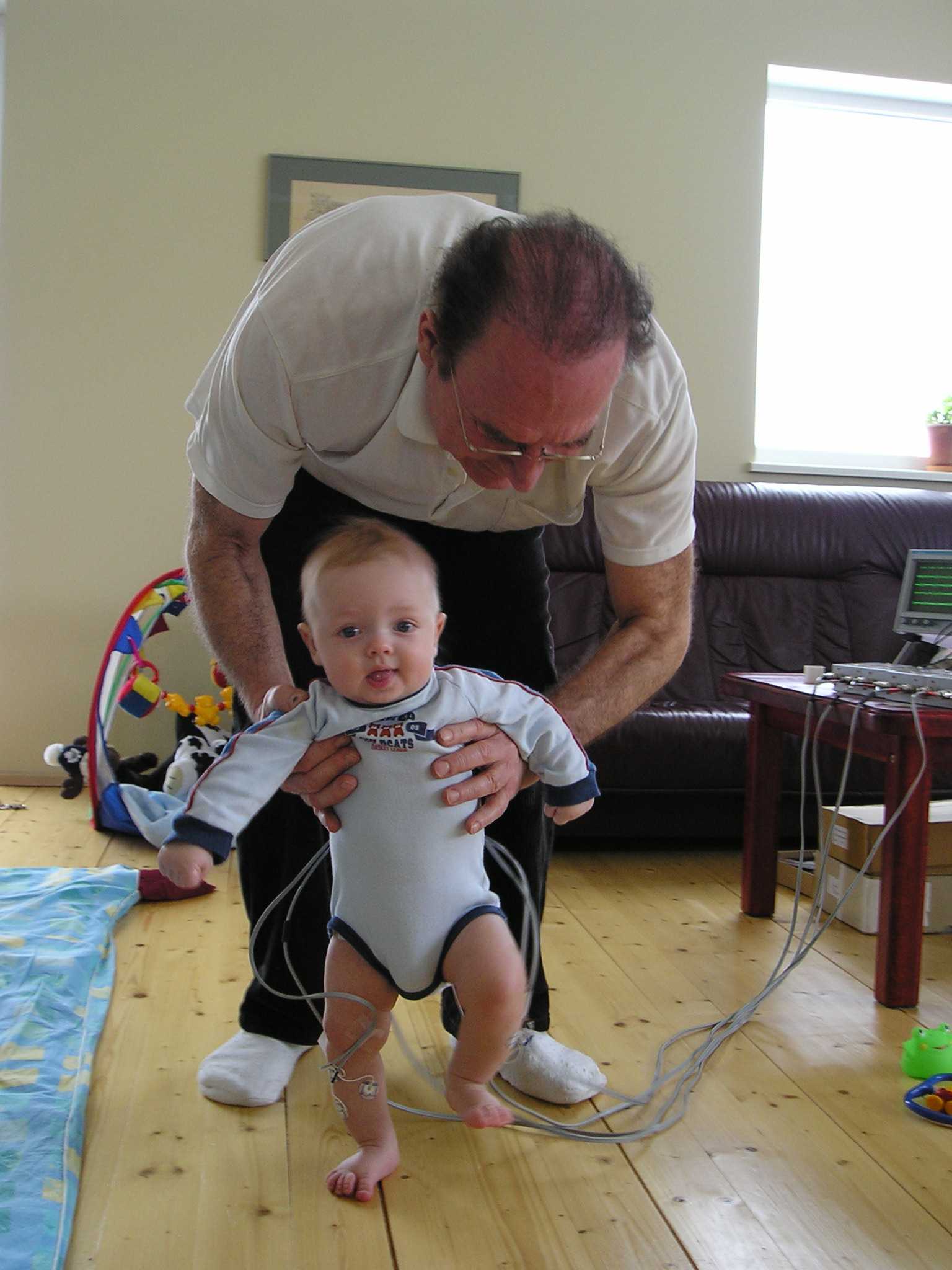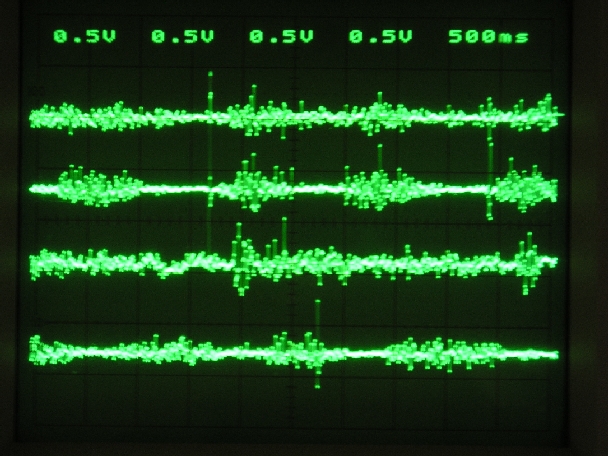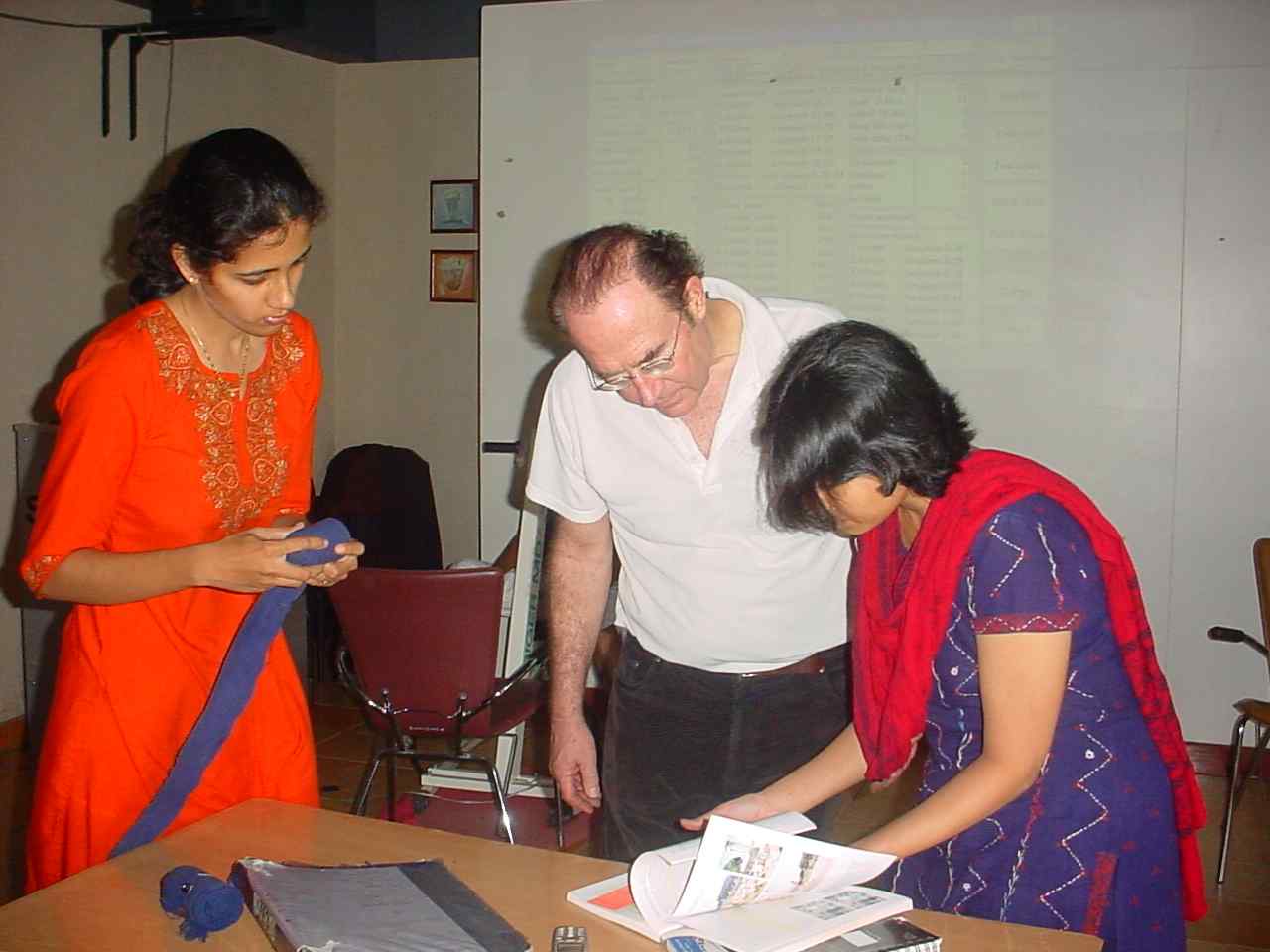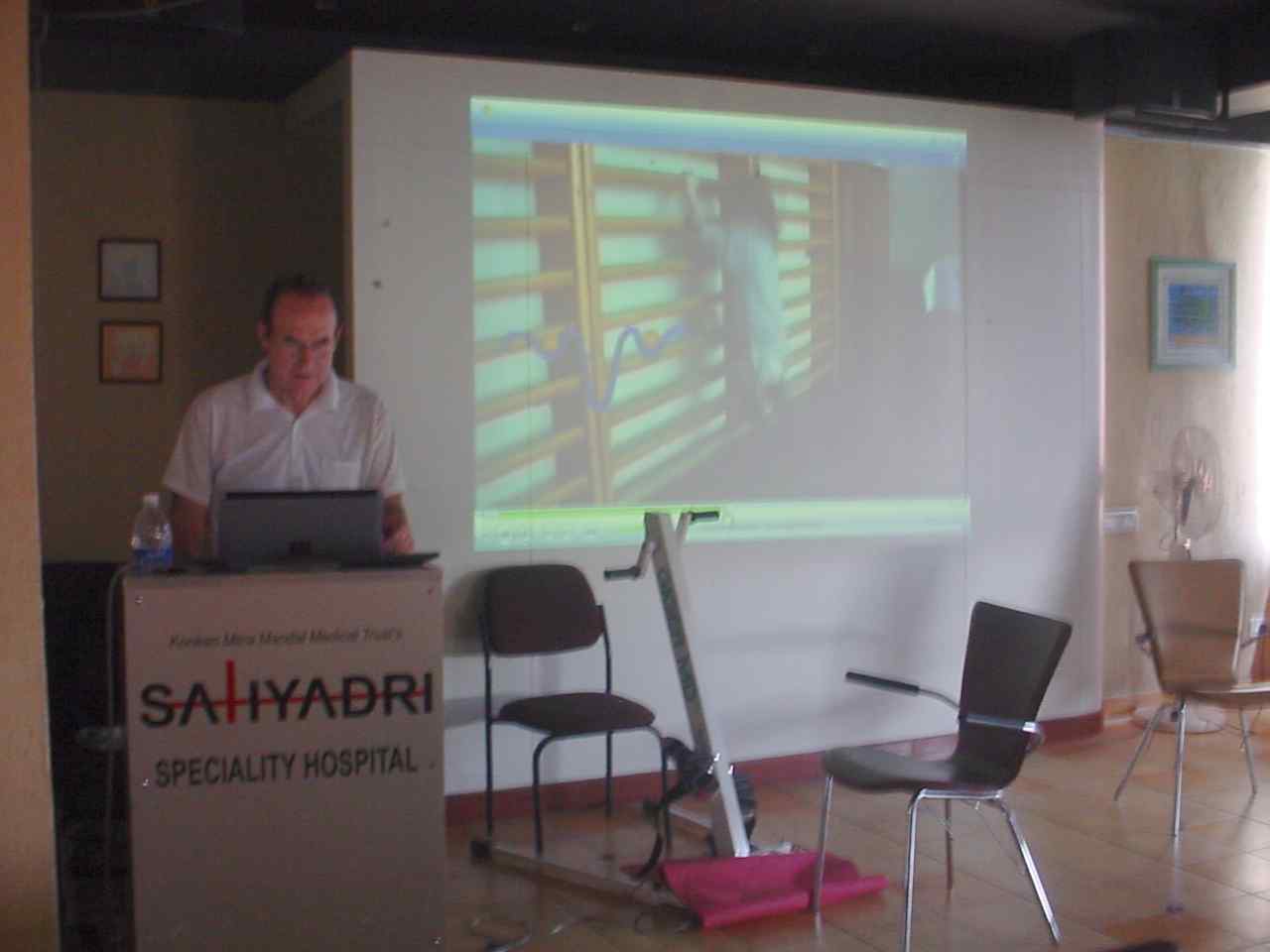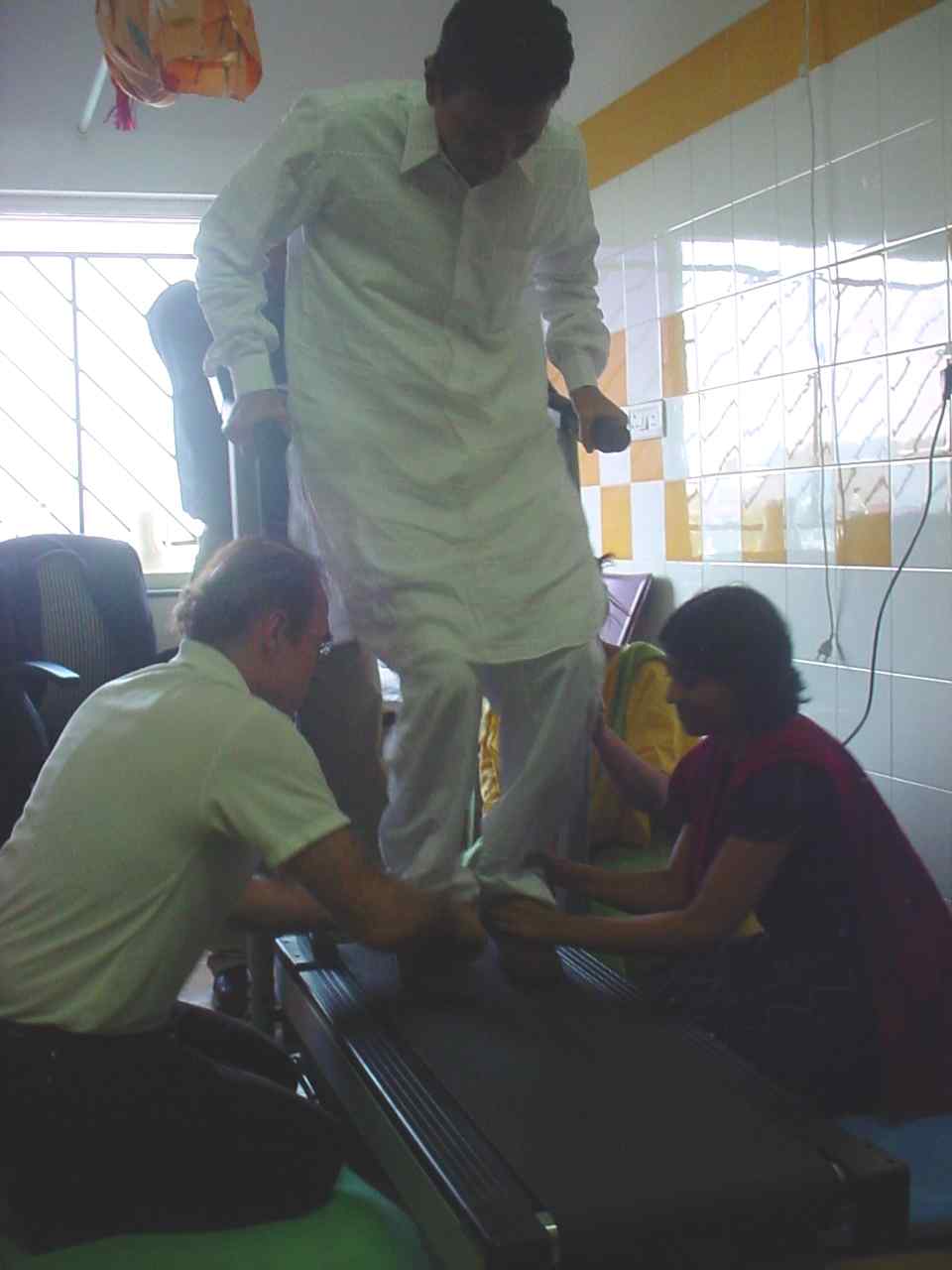|
|
NEUROTHERAPY Neurotherapy Course |
||||||||||||||||||||||||||||
|
Participants: Physicians, Physiotherapists, Physiotherapy students, Medical students, Neuroscientists. Main lecturer: Prof. Giselher Schalow. Place: Tartu University, Institute of Exercise Biology and Physiotherapy 5 Jakobi Str. 51014 Tartu ESTONIA Tel/fax: (+372 7)376286 E-mail: g_schalow@hotmail.com Date: 14.3.2004 – 20.3.2004, 6 hours per day during the 7-days course. Costs: Costs for the 7-days course = 700 €. Costs for the hotel ≈ 200 to 300 € for 7 days. Payment to: Certificate: There will be an examination at the end of the course and a certificate will be given for successful attending. Preliminary Program Sunday, 14.3.2004: 9.00-13.00: Introduction to neurotherapy, excitability of neurons, classification of human nerve fibres. Organization of reflexes (anatomical substrate and physiological importance). Small neuronal networks (anatomical and physiological). Natural impulse patterns in the human nervous system of α and γ-motoneurons, spindle afferents and skin afferents, different spinal oscillators (neural assembles), their properties and their coordinated firing. Potentiation of synapses. Long-term-potentiation. Gap-junctions. 15.00-17.00: Measurements of coordination dynamics in healthy humans and patients with spinal cord injury, brain injury, cerebral palsy, Parkinson’s disease etc... Monday, 15.3.: 9.00-13.00 and 15.00-17.00: Theory of coordination dynamics therapy. Tuesday, 16.3.: 9.00-13.00 and 15.00-17.00: Practical working with patients with spinal cord injury, brain injury, cerebral palsy and Parkinson’s disease (Coordination dynamics therapy): Crawling in interpersonal coordination, up-righting, swinging, jumping, treadmill walking, supported exercising on the special coordination dynamics therapy device. Wednesday, 17.3.: 9.00-13.00: Functional Anatomy (Assoc. Prof. Kolts). Dissection of spinal cord and cauda equina, lumbal-sacral nerve roots, spinal nerves and blood supply of the spinal cord. Anatomical demonstration of spinal cord injury, disc prolapse, radiculitis and piriformis syndrome. 15.00-17.00: Examination (multiple choice). Thursday, 18.3.: 9.00-13.00 and 15.00-17.00: Human neuromuscular performance testing and kinesiology (Prof. M. Pääsuke): muscle strength, electromyostimulation, H-reflex, 3-D gait analysis (walking cycles, cycles of the special coordination therapy device). Friday, 19.3.: 9.00-13.00 and 15.00-17.00: Surface electromyography (sEMG) in healthy and patients. Saturday, 20.3.: 9.00-13.00 and 15.00-17.00: Working with patients in the coordination dynamics therapy place in Tallinn.
Evaluation and measuring course; participants learn to measure and to evaluate the state of the CNS of patients on the neuron, the muscle and the movement level. Costs: Costs for the 7-days course = 700 €. Costs for the hotel ≈ 200 to 300 € for 7 days. Payment to: Preliminary Program Sunday, 6.6.2004: 9.00-13.00 and 15.00-17.00: Theory of coordination dynamics therapy. Monday, 7.6.: 9.00-13.00 and 15.00-17.00: Learning to measure coordination dynamics on healthy subjects and patients with spinal cord injury. Tuesday, 8.6.: 9.00-13.00 and 15.00-17.00: Learning to measure motor programs with surface EMG on healthy subjects and patients with CNS injury (Recording of physiologic and pathophysiologic motor programs. Judging movement performance by the quality of motor programs. Wednesday, 9.6.: 9.00-13.00 and 15.00-17.00: Learning to measure single motor unit firing with sEMG. Recording of firing of single FF-type motor units. Recording of oscillatory firing of FF-type motor units. Thursday, 10.6.: 9.00-13.00 and 15.00-17.00: Functional Anatomy (Assoc. Prof. Kolts). Dissection of the central nervous system including the brain in man. Dissection of fresh fixed brains of animals (pig or cow). Friday, 11.6.: 9.00-13.00 and 15.00-17.00: Neuromuscular performance tests and measurement (H-reflex, muscle strength, muscle contractile properties) (Prof. M. Pääsuke). Kinesiology (Prof. M. Pääsuke): 3-D gait analysis (walking cycles, cycles of the special coordination therapy device) in healthy and in a patient with spinal cord injury (injury level after trauma (Th5/7) after 1.5 years of coordinations dynamics therapy). Saturday, 12.6.: 9.00-13.00: Repeat of coordination dynamics theory. Discussion of evaluation measurements of patients. Answering of questions. 15.00-17.00: Examination.
Participants are introduced to system theory of pattern formation of the human central nervous system (CNS) and its consequences for Neurotherapy. The correspondence between coordinated movements and coordinated single neuron firing dynamics in human are drawn. Application of Neurotherapy to cerebellum injury. Preliminary Program Sunday, 15.5.2005: 9.00-13.00 and 15.00-17.00: Theory of Schalow coordination dynamics therapy. Neuron level: Excitability of neurons, classification of human nerve fibres, natural impulse patterns in the human nervous system of extrafusal and intrafusal motoneurons, spindle afferents and skin afferents. Neural ensemble level: Classification of human premotor spinal oscillators, their firing patterns, their coordination and their recruitment for motor programs of rhythmic coordinated movements. Monday, 16.5: 9.00-13.00 and 15.00-17.00: Theory of Schalow coordination dynamics therapy. Movement level: System Theory of the dynamics of pattern formation (from synergetics). Cooperative stability, attractor state layout. Measuring of the differential stability of attractor states. Connection between movement level and neuron and neuron assembly level. Neurogenesis level: Movement-induced neurogenesis and its consequences for functional repair in CNS injury. Tuesday, 17.5: 9.00-13.00 and 15.00-17.00: Surface electromyography (sEMG) and coordination dynamics measurements in healthy subjects and in patients with CNS injury. Judging movement performance by the quality of motor programs. Wednesday, 18.5: 9.00-13.00 and 15.00-17.00: Functional anatomy of the cerebellum and its relation to coordinated movements and CNS repair. Coordination centres: Vestibulocerebellum (balance with respect to gravity), Spinocerebellum (muscle tone, coordination of antagonistic muscle groups), Cerebrocerebellum (precise and goal directed movements). Thursday, 19.5: 9.00-13.00 and 15.00-17.00: Neuromuscular performance tests and measurements (H-reflex, muscle strength, muscle contractile properties) (Prof. Pääsuke). Kinesiology (Prof. Pääsuke): 3-D gait analysis in a patient with cerebellum injury. Friday, 20.5: Applying coordination dynamics therapy to patients with CNS injury. Applied movements: Creeping, crawling, uprighting, swinging and jumping on springboard, free walking, treadmill walking and running, support on the special coordination dynamics therapy devices. Saturday, 21.5: 9.00-13.00:
Repeat of Schalow coordination dynamics theory. Discussion of evaluation
assessment of patients. Answering of questions.
------------------------------------------------------------------------------------- Pictures
of the course held in Tartu
Prof. Schalow during teaching: Explanation of the generation mechanism of an action potential.
Measuring of the coordination dynamics in a Parkinson’s disease patient (measuring of the arrhythmicity of exercising).
Performance of surface electromyography (sEMG) in a patient with cerebral palsy (sitting on the left) in the Institute of Exercise Biology and Sport Sciences, Tartu University: Explanation of the motor program.
Verification of the anatomy of the spinal cord, cauda equine, nerve roots, spinal nerves and different nerves and muscles. Anatomy Department, Tartu University (Assoc. Prof. Kolts, front left; Prof. Schalow, right).
Exercising different movements and positions among course participants on a special coordination dynamics therapy device in the lying position. Coordination dynamics therapy place Tallinn.
Exercising of crawling in interpersonal coordination: Rehabilitation physician right, patient with spinal cord injury sub Th5/7 on the left.
Participants during training with patients the up-righting (patient on the right; physiotherapy student during Dr. Degree study, Tartu University) and the swinging (left patient; physiotherapist in the 3. year) in spinal cord injury patients (injuries sub Th5/7 and Th12). Master Degree student on the right.
Participants of the course train leg support during treadmill walking in a patient with a spinal cord injury sub Th5/7.
Participants: Physicians, Physiotherapists, Physiotherapy students, Medical students, Neuroscientists. Main lecturer: Prof. Dr. Dr. Giselher Schalow. Place: Tartu University, Institute of Exercise Biology and Physiotherapy 5 Jakobi Str. 51014 Tartu ESTONIA Tel/fax: (+372 7)376286 E-mail: g_schalow@hotmail.com Date: 9.6.2006 – 16.6.2006, 6 hours per day during the 8-days course.
Preliminary Program Friday, 9.6.2006: 9.00-13.00 and 15.00-17.00: Theory of Schalow Coordination Dynamics Therapy. Introduction to Coordination Dynamics Therapy with Videofilm. Integrative level of CNS functioning: System theory of pattern formation (derived from synergetics). Collective or order parameters, physiologic and pathophysiologic attractor states, attractor state layout, cooperative stability of movement patterns, learning, symmetry learning. Therapy consequences of the equations of motions (dX/dt = Fintr(X) + ∑cinfFinf(X,t); the vector X designates the collective variables, Fintr stands for the intrinsic dynamics, Finf represents the different types of behavioural information (environmental, memorized, or intended behavioural information) of the order parameters. Practical application of the equations of motion to the jumping on the springboard with stability calculations for the jumping pattern in-phase and anti-phase. Functional Anatomy: Function of the Cerebellum with respect to Vestibulocerebellum (balance with respect to gravity), Spinocerebellum (muscle tone, coordination of antagonistic muscle groups), Cerebrocerebellum (precise and goal directed movements). Analysis of a patient with severe cerebellum injury and his improvement upon coordination dynamics therapy. Symmetry analyzation of arm and leg movements. Patient-sided teaching: Coordination dynamics therapy (training of automatisms, of rhythmic dynamic stereotyped movements, and old learned movements like crawling, jumping, walking, exercising on the special coordination dynamics therapy device, climbing staircases, …) with a spinal cord injury patient (C5/6). Analyzing the Magnetic Resonance Image (MRI) of the patient with respect to the movements performed. Kinesiology: Measuring of the coordination dynamics. Demonstration of attractor states and pattern stability (in healthy subjects and in the patient) in the recorded coordination dynamics pictures. Recording of the differential stability of attractor states. Saturday, 10.6. 2006: 9.00-13.00 and 15.00-17.00: Theory of Schalow coordination dynamics therapy. Neuron level: Excitability of neurons, classification of human nerve fibres, natural impulse patterns in the human nervous system, spindle afferents, urinary bladder and skin afferents. Recruitment of neuron firing according to the size principle in each motoneuron group. Phase and frequency coordination among neuron firings. Explanation why electrical stimulation of muscles and nerves can be dangerous in patients (based on measurements of natural impulse pattern in the human CNS). Impairment of the natural firing patterns in the human CNS following CNS injury with the consequences for treatment. Neural ensemble level: Classification of human premotor spinal oscillators (innervating fast, intermediate and slow muscle fibres), their firing patterns, their coordination and their recruitment for motor programs of rhythmic coordinated movements. Parkinson tremor as a consequence of pathologic synchronization of oscillatory firing motoneurons. Treatment of Parkinson patients. Recording of coordination dynamics in a Parkinson patient. Patient-sided teaching: Practical working with spinal cord injury (C5/6 and Th10/11) and Parkinson patients. Electrophysiology (surface EMG): Recording of motor programs and single-motor unit firings from spinal cord injury and/or Parkinson patients. Sunday, 11.6.2006: 9.00-13.00 and 15.00-17.00: Comparison between the repair of the injured CNS and physiologic development: Introduction to surface electromyography (sEMG). Recording of sEMG in a 9-month-old healthy boy. Judgement of his motor functions: creeping, crawling, walking, and goal-oriented movements. Comparison of his motor functions and EMG motor patterns with those of spinal cord injury patients. Coordination dynamics measurements in healthy subjects and in patients with CNS injury. Judging movement performance and quality of motor programs. Patient-sided teaching: Participants are taught to apply coordination dynamics therapy to patients. Monday, 12.6.2006: 9.00-13.00 and 15.00-17.00, Prof. Pääsuke: Neuromuscular performance tests and measurements (H-reflex, muscle strength, muscle contractile properties). Kinesiology: 3-D gait analysis in a patient with an incomplete spinal cord injury. Tuesday, 13.6.2006: 9.00-12.00: Patient-sided teaching: Practical working with spinal cord injury patient. Afternoon: Journey to a castle: Discussion of the treatment ‘Coordination dynamics therapy combined with stem cell therapy’ in historic environment. Wednesday, 14.5: Journey to Tallinn (900-year old Hanse town): Repeating of coordination dynamics therapy in historic surrounding, discussions. Thursday, 15.5: 9.00-13.00: Repeat of Schalow coordination dynamics theory. Discussion of evaluation assessment and other neuro-therapies. Answering of questions. Patient-sided teaching: Applying coordination dynamics therapy to patients with CNS injury. Applied movements: Creeping, crawling, uprighting, swinging and jumping on springboard, free walking, treadmill walking and running, support on the special coordination dynamics therapy devices. 15.00-17.00: Examination and discussion. Thursday, 16.5: Free day or course in coordination dynamics measurements and/or sEMG.
Fig.1. Methods for research and treatment.
Fig. 2. Recording of surface EMG from a patient with a cervical spinal cord injury.
Fig. 3. Recording of surface EMG from a healthy 5 months old baby.
Fig. 4. Surface EMG recording from a healthy 5 months old baby.
Participants: Ideal for physiotherapists/teaching faculty, physiotherapy students, neuro-rehabilitation experts, all health-care professionals involved in treating intractable neurological disability and interested students and interns. Neurophysicians, neurosurgeons, post-graduate students, medical students, neuroscientists, neurophysiology students. Concept: A radically different and unique approach based on system theory of pattern formation and human neurophysiology is applied to diagnosis and treatment of patients with intractable neurological
disability - like stroke, spinal cord injury, traumatic brain injury, cerebral palsy, Parkinson’s disease. The theory of coordination dynamics therapy has its scientific basis in the coordination dynamics of single neurons, neural assemblies, and integrative functions of the human CNS. The effectiveness of treatment based on this concept has been proved by nearly 100 successfully treated and improved neurologically disabled patients in
the last few years, who were condemned to be hopeless cases by conventional neurology and physiotherapy. These cases have been widely published in international peer-reviewed journals. In this first international course in India, the theory and concept of coordination dynamics therapy is explained in detail. A large emphasis is also placed on practical training and bed-side teaching and working with
patients - that will help therapist to treat his/her patients.
For contact, for registration and any queries Phone: 91-25403000, Ext. 1308 (working
hours: 10 am to 6 pm) Date: 24.11.2006 – 01.12.2006, 6 hours per day during the 8-days course Course fees: 15,000 INR Payment: Cheque/DD drawn favouring ‘Sahyadri Hospitals Ltd.’, payable at Pune Last date of registration: 15th Nov 2006. Course is open only for 25 participants, on first come first serve basis Certificate: There will be an examination at the end of the course and a certificate will be given for successful attending Form for registration: Please download the form, fill it and send it to g_schalow@hotmail.com (CC to neuro@sahyadrihospitals.com) Please send Cheque/DD drawn favouring ‘Sahyadri Hospitals Ltd.’, payable at Pune; along with duly filled registration form and a self-addressed envelope Please address your covering envelope as follows:
Preliminary Program Friday, 24/11/2006
Saturday, 25/11/2006
Sunday, 26/11/2006
Monday, 27/11/2006
Tuesday, 28/11/2006
Wednesday, 29/11/2006
Thursday, 30/11/2006
Thursday, 30/11/2006
|
